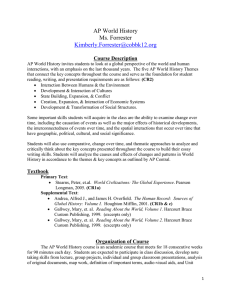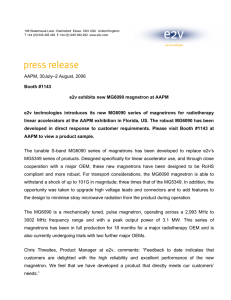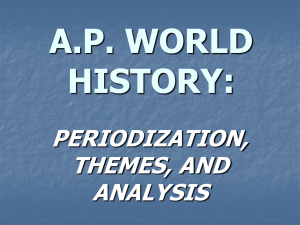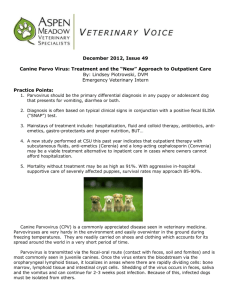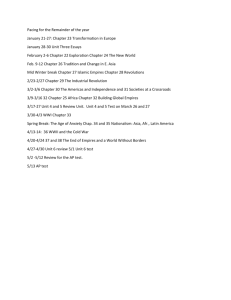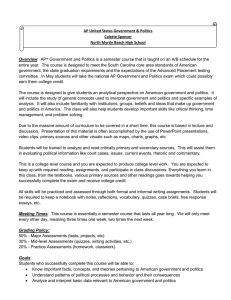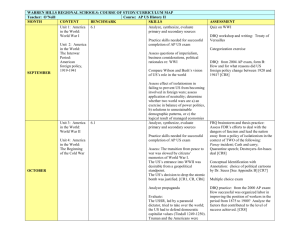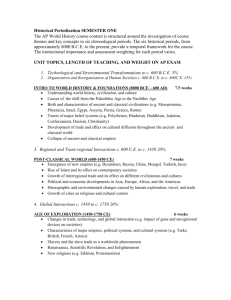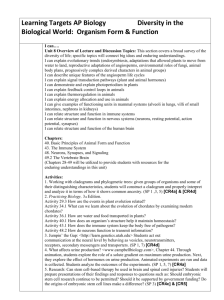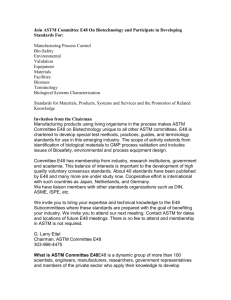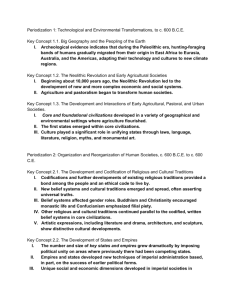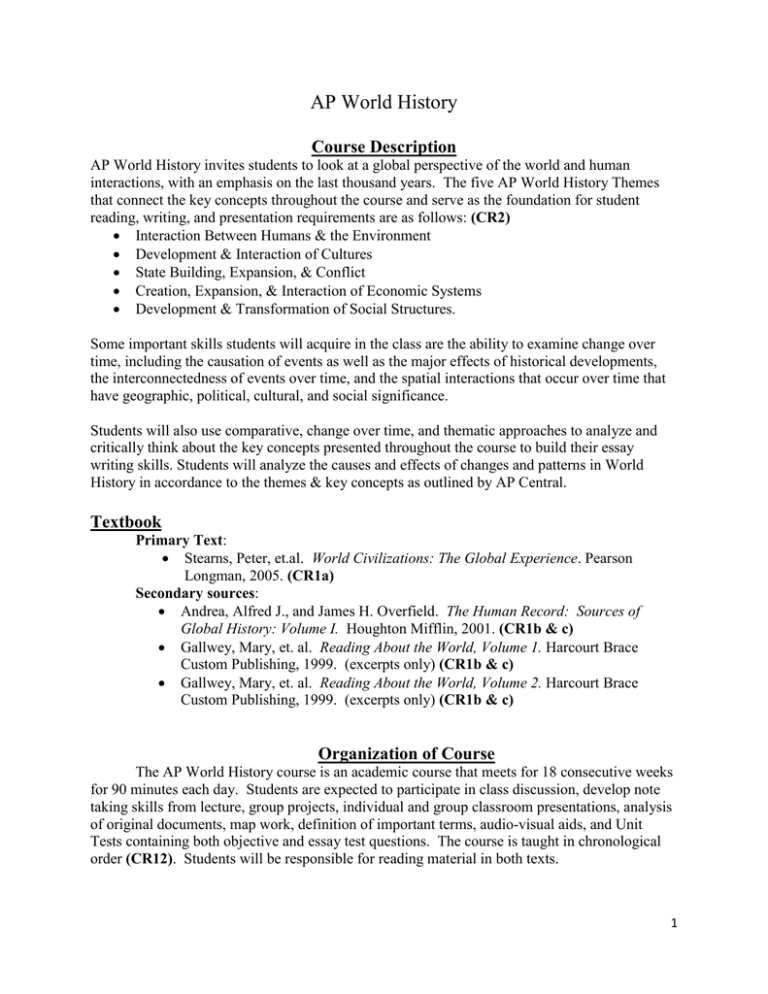
AP World History
Course Description
AP World History invites students to look at a global perspective of the world and human
interactions, with an emphasis on the last thousand years. The five AP World History Themes
that connect the key concepts throughout the course and serve as the foundation for student
reading, writing, and presentation requirements are as follows: (CR2)
Interaction Between Humans & the Environment
Development & Interaction of Cultures
State Building, Expansion, & Conflict
Creation, Expansion, & Interaction of Economic Systems
Development & Transformation of Social Structures.
Some important skills students will acquire in the class are the ability to examine change over
time, including the causation of events as well as the major effects of historical developments,
the interconnectedness of events over time, and the spatial interactions that occur over time that
have geographic, political, cultural, and social significance.
Students will also use comparative, change over time, and thematic approaches to analyze and
critically think about the key concepts presented throughout the course to build their essay
writing skills. Students will analyze the causes and effects of changes and patterns in World
History in accordance to the themes & key concepts as outlined by AP Central.
Textbook
Primary Text:
Stearns, Peter, et.al. World Civilizations: The Global Experience. Pearson
Longman, 2005. (CR1a)
Secondary sources:
Andrea, Alfred J., and James H. Overfield. The Human Record: Sources of
Global History: Volume I. Houghton Mifflin, 2001. (CR1b & c)
Gallwey, Mary, et. al. Reading About the World, Volume 1. Harcourt Brace
Custom Publishing, 1999. (excerpts only) (CR1b & c)
Gallwey, Mary, et. al. Reading About the World, Volume 2. Harcourt Brace
Custom Publishing, 1999. (excerpts only) (CR1b & c)
Organization of Course
The AP World History course is an academic course that meets for 18 consecutive weeks
for 90 minutes each day. Students are expected to participate in class discussion, develop note
taking skills from lecture, group projects, individual and group classroom presentations, analysis
of original documents, map work, definition of important terms, audio-visual aids, and Unit
Tests containing both objective and essay test questions. The course is taught in chronological
order (CR12). Students will be responsible for reading material in both texts.
1
Student Evaluations
Each unit of study includes vocabulary quizzes, several daily grades such as student
activities, journal entries, map activities, one major project, several mini-projects, essay writing,
and the unit exam. Map quizzes are given throughout the semester and may be separate from the
unit of study.
Description:
% of Grade
Tests
35%
Classwork/Homework
20%
Projects
15%
Final Exam
20%
Quizzes
10%
Test: Each Unit will have an exam (larger units will be broken down into smaller “units’ to be
tested on.) The tests will consist of multiple choice and essay questions to simulate the AP
Exam.
Classwork/Homework: Any assignment given to be completed as classwork or homework such
as map activities, timelines, charts and maps, vocabulary, & essays. Essays are a major
foundation of the course and there are three types of essays we will work on:
1. Document Based Questions (DBQs): Students analyze evidence from a variety of
sources in order to develop a coherent written argument that has a thesis supported by
relevant historical evidence. Students will apply multiple historical thinking skills as they
examine a particular historical problem or question. (CR6)
2. Change and Continuity Over Time (CCOT): Students identify and analyze patterns of
continuity and change over time and across geographic regions. They will also connect
these historical developments to specific circumstances of time and place, and to broader
regional, national, or global processes. (CR10)
3. Comparative Essay: Students compare historical developments across or within
societies in various chronological and/or geographical contexts. Students will also
synthesize information by connecting insights from one historical context to another,
including the present. (CR14)
Students will also be required to participate Socratic Seminars: During lecture and note taking
students will engage in classroom discussions about the daily lesson allowing them to identify
and evaluate the historical information presented to them and allowing them and their classmates
to interpret what the information (CR7)
Projects: Students will do an individual project in which they produce a research paper on a
historical figure or major event of their choice prior to 1970. They must produce a thesis of
how/why the individual/event is relevant/important to World History and produce supporting
evidence using primary and secondary sources. (CR6) There will also be a group project in
which groups will research and create their own DBQ, or Document Based Question. Students
2
will research to find both secondary and primary materials for their exam. Once the DBQ has
been created the students will author a reflection on why they chose the subject and content that
they did, the process in which they followed, and what they learned from the exercise. (CR4,
CR8)
Journals: Students will be required to keep a journal to write in during the semester. Journals
will include reading analysis, analysis of primary & secondary sources, personal thoughts and
opinions on various historical events/regions studied, film analysis, critical thinking of various
historical themes, and contextualization of learning for each unit of study (CR13)
Binder: Students will be required to keep a 3-Ring Binder with dividers to keep all notes,
handouts, quizzes, vocabulary, practice DBQ & COT essays, etc. in as a study reference to use
throughout the semester. The binder is part of your classwork grade.
Binders checks will be both announced and unannounced
Quizzes: Quizzes will be administered throughout the semester. Quizzes will consist of both
multiple choice or fill-in-the-blank questions.
Final Exam: The final exam will be a released AP Exam to best test student knowledge and
growth through the semester.
This is worth 15% of your FINAL grade
Course Content
This course is underscored by its expansive chronology. College Board has identified five main
time periods and Key Concepts to for each period as outlined by College Board: (CR3)
I. Foundations, circa 8000 B.C.E.–600 C.E. Technological and Environmental
Transformations
• Key Concept 1.1. Big Geography and the Peopling of the Earth
• Key Concept 1.2. The Neolithic Revolution and Early Agricultural Societies
• Key Concept 1.3. The Development and Interactions of Early Agricultural, Pastoral and
Urban Societies (CR 3)
Topics for Overview include: (CR5a – CR5e)
• Prehistoric Societies
• From Foraging to Agricultural and Pastoral Societies
• Early Civilizations: Middle East, South Asia, East Asia, the Americas, Africa, and
Oceania
Special Focus:
Issues Regarding the Use of the Concept of Civilization
Activities & Skill Development
• Students will examine a textual document excerpt “Hammurabi’s Law Code” from The
Babylonian Laws edited by G.R. Driver and John C. Miles to analyze the following:
(CR1b, CR 8, & CR14)
o Analyze the relationship between social and family structures
o Analyze the relationship between law and trade
3
•
•
•
•
o Examine how Hammurabi’s law can/can not connect to laws of society today and
why
Students will examine Guns, Germs, and Steel Episode 1: Out of Eden and Students will
analyze how geography affected the development of political, social, economic, and
belief systems in the earliest civilizations according to historian Jared Diamond.(CR8,
CR9, & CR15)
Students will read and analyze a written excerpt of The Mandate of Heaven with an
introduction by Andrea & Overfield. (CR1b & c)
Map activities (CR8)
Timeline Activity (CR12)
II. 600 B.C.E – 600 C.E. Organization and Reorganization of Human Societies
• Key Concept 2.1. The Development and Codification of Religious and Cultural
Traditions
• Key Concept 2.2. The Development of States and Empires
• Key Concept 2.3. Emergence of Trans-regional Networks of Communication and
Exchange (CR3)
Topics for Overview include: (CR5a-5c & 5e)
• Classical Civilizations
• Major Belief Systems: Religion and Philosophy
• Early Trading Networks
Special Focus:
• World Religions
o Animism focusing on Australasia and Sub-Saharan Africa
o Judaism and Christianity
o Hinduism and Buddhism
o Daoism and Confucianism
• Developments in Mesoamerica and Andean South America: Moche and Maya
o Bantu Migration and its Impact in Sub-Saharan Africa
o Transregional Trade: the Silk Road and the Indian Ocean
o Developments in China—development of imperial structure and Confucian society
Activities & Skill Development
In groups Students will evaluate the causes and consequences of the decline of the Han,
Roman, and Gupta empires (CR9)
Students will research and present a major world religion/belief system examining the following:
o Origin
o beliefs and practices
o diffusion
(CR7) & (CR15)
Students will watch seeing the PBS Nova program “Cracking the Maya Code,” students
will analyze & discuss the impact that archaeology and iconography have had on the
study of world history (CR7) & (CR15)
Students will read and analyze the type of source & tone of the following two historical
documents: Hinduism: The Way of Devotion & Vishnu, Destroyer of Sin with an
introduction by Andrea & Overfield. (CR1b & c, CR5c, CR8)
4
Students will analyze and interpret the authors point of view, intended audience &
purpose, & tone in regards to views of slavery in classical civilizations from the
following historical documents (CR 7 & CR8):
o Plato’s Republic
o Aristotle’s Economics
o Tacitus the Annals
o Gaius, Textbook in Law
o The Laws of Manu
Students will analyze and interpret population and religion tables from “The Patterns of
Islam’s Global Expansion” from The World Almanac and Book of Facts 2000 (CR1c)
Map activities (CR8)
Timeline Activity (CR12)
evaluate the periodization in Ch.3—i.e. the use of 200 CE as a break as opposed to the
periodization of the course curriculum (CR11)
III. 600 – 1450 Regional and Trans-regional Interactions
• Key Concept 3.1. Expansion and Intensification of Communication and Exchange
• Networks
• Key Concept 3.2. Continuity and Innovation of State Forms and Their Interactions
• Key Concept 3.3. Increased Economic Productive Capacity and Its Consequences (CR3)
Topics for Overview include: (CR5a-5c & 5e)
• Byzantine Empire, Dar-al Islam, &
• The Turkish Empires
Germanic Europe
• Italian city-states
• Crusades
• Kingdoms & Empires in Africa
• Sui, Tang, Song, and Ming empires
• The Mongol Khanates
• Delhi Sultanate
• Trading Networks in the Post• The Americas
Classical World
Special Focus:
• Islam and the establishment of empire
• Polynesian Migrations
• Empires in the Americas: Aztecs and Inca
• Expansion of Trade in the Indian Ocean—the Swahili Coast of East Africa
Activities & Skill Development
Students will examine Guns, Germs, and Steel Episode 2: The Conquest and Students
will analyze how geography affected the development of political, social, economic, and
belief systems in the earliest civilizations according to historian Jared Diamond.
Specifically focusing on European expansions impact on Africa. (CR8, CR9, & CR15)
Students will read a portion of Marco Polo, Description of the World with an
introduction on Traveling the Silk Road by Andrea & Overfield. (CR1b & c, CR5c)
Students will analyze the historical context and also why people lived in cities and towns
on the route, dangers urban people encounter, and the Mongol’s impact on the Silk Road.
(CR7, CR9)
Map activities (CR8)
Timeline Activity (CR12)
5
evaluate the periodization in the book compared to that of the periodization in the
course curriculum. Why 200-1000 CE and 1000-1500 CE instead of 600-1450? (CR11)
IV. 1450 – 1750 Global Interactions
• Key Concept 4.1. Globalizing Networks of Communication and Exchange
• Key Concept 4.2. New Forms of Social Organization and Modes of Production
• Key Concept 4.3. State Consolidation and Imperial Expansion (CR3)
Topics for Overview include: (CR 5b, 5c, 5e)
• Bringing the Eastern and Western Hemispheres Together into One Web
• Ming and Qing Rule in China
• Japanese Shogunates
• The Trading Networks of the Indian Ocean
• Effects of the Continued Spread of Belief Systems
• Special Focus:
• Three Islamic Empires: Ottoman, Safavid, Mughal
• Cross-Cultural Interaction: the Columbian Exchange
• The Atlantic Slave Trade
• Changes in Western Europe—roots of the “Rise of the West” [CR5e]
Special Focus:
• Three Islamic Empires: Ottoman, Safavid, Mughal
• Cross-Cultural Interaction: the Columbian Exchange
• The Atlantic Slave Trade
• Changes in Western Europe—roots of the “Rise of the West” [CR5e]
Activities & Skill Development
• Students will watch Guns, Germs, and Steel Episode 3: Into the Tropics and Students will
analyze how geography affected the development of political, social, economic, and
belief systems in the earliest civilizations according to historian Jared Diamond.
Specifically the consequences of European expansion. (CR8, CR9, & CR15)
• Students will analyze the purpose and intended audience of a portion of Abu’l Fazl,
Akbarnama with an introduction by Andrea & Overfield on The Mughals and the West.
(CR1b & c, CR5c)
• Students will analyze the Primary Source document The Interesting Narrative of the Life
of Olaudah Equiano or Gustavus Vassa the African (1789). The students will analyze the
historical context of the source and the author’s point of view. (CR1b, CR 8, &CR13)
• Map activities (CR8)
• Timeline Activity (CR12)
• Consider the question of periodization: 1750 or 1800? (CR11)
V. 1750 – 1900
• Key Concept 5.1. Industrialization and Global Capitalism
• Key Concept 5.2. Imperialism and Nation—State Formation
• Key Concept 5.3. Nationalism, Revolution and Reform
• Key Concept 5.4. Global Migration (CR3)
Topics for Overview include: (CR5a & 5b)
• The Age of Revolutions:
6
English Revolutions, Scientific Revolution & Enlightenment,
American Revolution, French Revolution and its fallout in Europe, Haitian &
Latin American Revolutions
• Global Transformations:
Demographic Changes, the End of the Atlantic Slave Trade, Industrial Revolution
and Its Impact, Rise of Nationalism, Imperialism and its Impact on the World
Special Focus:
• Decline of Imperial China and the Rise of Imperial Japan
• 19th Century Imperialism: Sub-Saharan Africa, South and Southeast Asia
• Comparing the French and Latin American Revolutions
• Changes in Production in Europe and the Global Impact of those Changes [CR5e]
Activities include:
Students will read primary sources dealing with women in the Industrial Revolution.
They will examine the changing role of women compared to men, how difference
between middle-class and working-class women, and how the role of women has
changed since then. (CR14)
Students will examine the “Jamaica Letter” (1815) by Dimon Bolivar and analyze its
historical context in regards to the role of Hispanic heritage on Latin American
independence. (CR8)
Student will analyze political cartoons about European Imperialism in Africa and Asia to
analyze how nationalism and the Industrial Revolution influenced expansion (CR1b)
Map Activity (CR8)
Timeline (CR12)
Consider the question of periodization: 1900 or 1914? (CR11)
VI. 1900-present: Accelerating Global Change and Realignments
• Key Concept 6.1. Science and the Environment
• Key Concept 6.2. Global Conflicts and Their Consequences (CR9)
• Key Concept 6.3. New Conceptualizations of Global Economy, Society and Culture (CR3)
Topics for Overview include: (CR5a-c & 5e)
• Crisis and Conflict in the Early 20th Century:
• Anti-Imperial Movements, World War I, Russian, Chinese and Mexican Revolutions,
• Depression, Rise of Militaristic and Fascist Societies, World War II
• Internationalization
• Decolonization, the Cold War World, International Organizations, the Post-Cold War
• World, Globalization
Special Focus:
• World War I and World War II: Global Causes and Consequences (CR9)
• Activity—Skill Development
o Students will identify and analyze the causes and consequences of the global
economic crisis in the 1930s
• Development of Communism in China, Russia, and Cuba (CR5b & c)
• Responses to Western Involvement in Sub-Saharan Africa: Imperialism, the Cold War,
and International Organizations (CR5a)
Activities include:
7
•
•
•
•
Students will read Marie Sukloff: The Story of an Assassination (1914) and analyze the
authors point of view and tone (CR8)
Students will analyze the historical context, purpose, and intended audience of various
images portraying women’s role in WWII. Including images of: Rosie the Riveter, a
female Air Force officer on the cover of Time Life, and various propaganda images
encouraging women to take men’s place in the workforce.(CR 1b & CR8)
Students debate the benefits and negative consequences of the rapid advances in
science during the 20th and early 21st centuries (CR9 & 10)
Students will evaluate the following scholarly historical interpretations and analyze the
role of the German people in the Holocaust: Ordinary Germans and the Holocaust by
Daniel Jonah Goldhagen, Memories of the White Rose by Dr. George J. Wittenstein, and
The Hitler Youth by Phillip Gavin (CR1c & CR7)
Students trace the development of one form of popular culture in the 20th century and
present examples. (CR10 & 13)
Map Activity (CR8)
Timeline (CR12)
8

